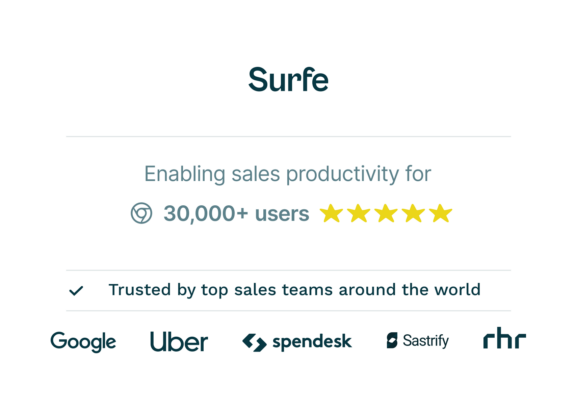7 things every startup founder should know about cash efficiency

Running a startup is tough. Really tough.
The majority fail in the first 4 years, with just over a third making it to 5 years.
Scaling, in particular, can feel like a crazy mountain to try and climb. You need to constantly prove your solution’s viable – to new hires, to investors, to (dare I say it) yourself. It can be really easy to get caught up in growth metrics and ARR milestones, without thinking about how sustainable this growth actually is. Every founder’s been there!
Here’s the thing. The sooner you start prioritizing healthy growth – that is, growth alongside cash efficiency – the sooner you’ll start seeing those numbers rise without the added anxiety of a shortening runway.
Scaling efficiently means staying lean, optimizing resources, and making sure every dollar drives impact. And that’s exactly what we’re going to talk about today, featuring 7 tactics that have worked for Surfe:
- Look for Positive ROI Per Headcount
- Do the Work Yourself First, Then Outsource to Scale
- Invest Early in Your ‘Office of the CFO’
- Hire Based on Pain Points and Opportunities
- Focus on the 80/20 Rule
- Prioritize Organic Growth Over Paid Channels
- ROI-Driven Product Development
Without further ado – let’s get going:
1. Look for Positive ROI Per Headcount
One of the biggest mistakes startups make is scaling headcount too quickly. This gets really expensive, really fast – and creates a load of brand-new complexities around operations, people management, and decision-making for you to deal with. In other words, it’s a surefire way to become way less efficient while burning a load of cash. No thanks!
At Surfe, we’re taking a more cautious approach: every hire has to bring a positive return on investment. In practice, this means implementing performance reviews and OKRs early on and tying them to measurable outcomes.
This doesn’t mean that all we do is track productivity and assess performance. We do do those things, but doing so allows every person to connect the work that they do directly to career growth, promotions, and salary adjustments. Every team member contributes meaningfully to our bottom line – and understands exactly how they do so, too.
Lesson: hire strategically, when the business impact justifies it. For example, at Surfe the sales team only grows after we’ve hit 90% of our revenue targets.
2. Do the Work Yourself First, Then Outsource to Scale
When Romain and I first started Surfe, we were knee-deep in every process. Sales, marketing, product development…you name it, we did it!
This wasn’t just because we were strapped for resources – it was because we wanted to understand the ins and outs of each role before delegating.
Do the work yourself first, and you’ll be able to identify what’s truly important – and where you could be more efficient. Once you have a clear picture, you can outsource and delegate at scale, without compromising on efficiency or worrying about making an expensive mistake.
We’ve applied exactly the same method when scaling our team activity. For example, our marketing team started producing content in-house before hiring freelance writers to scale our efforts – once they knew their strategy was working.
Lesson: if you want to scale efficiently, learn the ropes yourself first and experiment in-house. Otherwise, you’ll end up wasting a lot of money – and even more time tidying up your mistakes.
3. Hire Based on Pain Points and Opportunities
A lot of startups start quickly hiring talent with the goal of scaling all activities. It’s easy to fall into this trap – particularly after a successful funding round – with the hope of speeding up growth.
Spoiler alert: this probably won’t work. One of the best decisions we made at Surfe was to avoid hiring just for the sake of growth. Instead, we bring new people on board based on specific problems or opportunities. For example, when we won a larger account we hired an account manager to dedicate to them. Nowadays our Customer Success team is made up of 5 people, all of whom solve a different problem. When SEO started to work for us we hired a dedicated Growth Marketing Manager to own it. And when we realised how big a channel Partnerships would be, we hired a Partnerships Manager to scale our Partner Program.
By making these hires when we knew we needed them – not before, and not in anticipation of needing them one day – we’re able to tie each role to ROI and not spend unnecessarily.
Lesson: scale your team strategically based on what you need to work on, not just because you hit a funding milestone.
4. Invest Early in Your ‘Office of the CFO’
If you’re serious about scaling, understanding your numbers is absolutely non-negotiable. You’ve got to be intimately acquainted with every single one – otherwise, you’re bound to get a nasty surprise sooner or later.
Early on at Surfe, we invested in building what I call our ‘Office of the CFO’. Tools like Fincome or Pigment give us a weekly cash flow overview – which allows us to be proactive, rather than reactive.
Our monthly reports are also long. Like, over 50 pages each time kind of long. This may seem like a lot of work – it is – but having this depth of visibility allows us to make the smartest decisions and build a predictable business model. It may not be the most glamorous task (it certainly wasn’t what I dreamed of before we began Surfe) but it’s one of the most critical on our plate.
Lesson: running a tight ship is about more than just budgeting. To do it sustainably, you need to create a predictable growth engine with no surprises.
5. Focus on the 80/20 Rule
20% of your efforts will produce 80% of your results. This principle has guided our strategy more than any other – and will continue to do so.
What does this mean in practice? Well, it means putting our energy in the right places. Being laser-focused on high-impact areas, and ruthless about cutting out what doesn’t move the needle.
Startups often fall into the trap of ‘business as usual’ – but if you can’t prove your efforts are making a big impact, you’re wasting your time. Equally, it can be easy to get distracted by shiny objects without considering whether they’re the most impactful thing you could be doing right now.
At Surfe, this looks like prioritizing customer success, optimizing our core features, and focussing on growth levers that drive the most value. In our experience, doubling down on what’s already working is the fastest way to grow.
Lesson: focus your time and resources on the areas that deliver the most impact. Everything else can wait: full stop.
6. Prioritize Organic Growth Over Paid Channels
Here’s something that might surprise you: paid channels only account for 5% of our growth at Surfe. Yes, 5%!
Instead, we focus on sustainable, organic channels like partnerships and SEO. Why? Well, paid channels can be a slippery slope if you haven’t optimized your spending – and over-reliance on them is only going to come back to bite you later down the line.
For example, at Surfe we’ve scaled our monthly SEO signups by 6x in 12 months. We know it’s working – and we aim to do the same thing next year. We’ve also learned that investing in existing customers, expanding accounts, and driving up NDR is far more effective and sustainable. Speaking of NDR – I recently shared my thoughts on NDR and scaling a B2B SaaS upmarket, if you want more behind-the-scenes info about Surfe (who doesn’t!).
Lesson: build a growth engine that doesn’t rely on burning cash. Think of paid channels as a cherry on top of your growth efforts, not the foundation.
7. ROI-Driven Product Development
Just like our hiring decisions, every product decision we make at Surfe is tied to ROI. Building a new feature is, 9 times out of 10, a shiny object. Unless there’s a clear return on investment, we’re not going to pursue it.
This mindset has helped keep our R&D spend efficient and makes sure that every update we roll out directly impacts our customers’ success. Which, ultimately, makes a positive change to our NDR.
Lesson: Tie every product update to a clear business case: it keeps your team focused and your growth sustainable.
Let’s Wrap It Up!
There’s no magic recipe for building a startup and scaling its growth. What worked for us undoubtedly won’t work for someone else – but what will work is putting cash efficiency at the core of your strategy.
Be cautious when hiring and spending, get very well acquainted with your numbers, and focus on the activities that will make the most impact. Taking this approach will help you make smarter decisions with the resources you already have – rather than spending all of your money on unsustainable growth.
2025, we’re ready for you – watch this space.

You can’t scale a business without prospecting…
…and you can’t prospect without Surfe. Better give it a go.
FAQs About Cash Efficiency in SaaS
What Is Cash Efficiency, And Why Does It Matter For SaaS Startups?
Cash efficiency means using your resources wisely to achieve sustainable growth. Cash efficiency makes sure that every dollar drives impact – which helps you avoid nasty surprises and build a predictable growth engine. In practice, this means staying super close to the numbers and approaching spending with a view to generating ROI every time.
How Can SaaS Startups Avoid Hiring Mistakes That Burn Cash?
Hire strategically! At Surfe, we only bring new people on board when the business impact justifies it. This means hiring based on pain points we’re experiencing or opportunities we have. For example, we hired a new account manager specifically to help with a large account we’d just won. Tie every hire to measurable outcomes like OKRs, and avoid scaling headcount too quickly – this is an expensive mistake that adds complexity unnecessarily. The key is focussing on ROI per team member to make sure everyone drives real value.
Why Should Founders Do The Work Themselves Before Outsourcing?
Founders who get hands-on first understand the ins and outs of their business better. At Surfe, we tackled everything ourselves early on – sales, marketing, product development, you name it, we did it – to identify what was truly important before delegating. This helped us scale efficiently without wasting time or money. By learning the ropes, you can spot inefficiencies, prioritize tasks, and make smarter outsourcing decisions.
What’s The Best Way For SaaS Startups To Track Financial Performance?
Invest early in tools that give you a clear financial picture, and make sure you’re taking the time to really understand the numbers. At Surfe, we use tools like Fincome and Pigment to track weekly cash flow and create detailed monthly reports. This visibility helps us make proactive, rather than reactive, decisions when growing the business. Knowing your numbers inside and out prevents surprises and makes sure you’re running a tight ship. It’s not glamorous, but understanding cash flow and profitability is the foundation of sustainable growth.
How Can SaaS Startups Reduce Dependence On Paid Growth Channels?
At Surfe, organic channels drive 95% of our growth, while paid accounts for just 5%. Paid channels can be a slippery slope if your spending isn’t optimized. Instead, we prioritize organic channels like partnerships and SEO, scaling existing accounts and driving up NDR (Net Dollar Retention). The right channel mix for you will depend on your unique business, but you should think of paid channels as the cherry on top – not the foundation – of your growth engine.


